Creating a garden from scratch can boost your mood and reduce stress. You can design your own garden in a fantastic way to connect with nature. A beautiful garden is not just about adding plants and pathways; it’s about creating harmony between space, texture, light, colour, and emotion.
Your garden tells a story of balance, warmth, and growth. Over time, you’ll shape a space that’s uniquely yours, elegant, and beautifully balanced between nature and design. You’ll notice that what gives you peace and joy is how each corner comes alive as the seasons change.
So, if you’re ready to dig in, here are 17 easy and inspiring steps on a budget to help you design your dream garden, a little patch of paradise that reflects your style and makes every day feel like spring. Whether you have a small balcony or a spacious yard, you’ll learn practical tips that can turn your gardening dreams into reality.
Before you start: Make a wishlist
Before you start designing your garden, it’s essential to make a wishlist. Think about what type of garden you want to create. Write down the plants and features you dream of, like a cozy seating area, vibrant flowers, or even a small water fountain. This wishlist helps clarify your vision and ensures your garden reflects your personality and style.
Next, consider the layout. Break it down into zones, such as entertainment areas, relaxation spots, and vegetable patches. Use natural pathways to guide the eyes and feet through the garden. Remember, incorporating layers like tall plants at the back and shorter ones in front creates a beautiful depth and keeps the scenery interesting.
Start with a comfortable sitting place. If you’re lucky enough to face the sunset, try to design your backyard layout so that the light catches your plants and adds a warm, golden glow to your evenings.
You need a space for storage. Just think practically, too. It should have a tiny garden shed. Maybe you’d like a vegetable patch, a flower border, or a space for weekend parties. Write it all down. This simple wishlist will become the foundation for your garden’s structure.
If you have a small city garden, focus on a simple layout with one or two standout features. Consider a mini water fountain, planted roses, or soft, decorative grasses in blush-toned containers. Keep your planting sketch minimal yet textured for that modern, effortless charm.
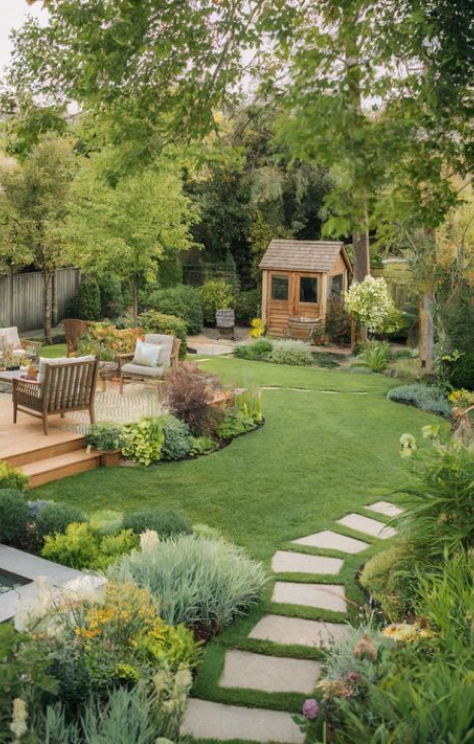
Consider the soil
When designing a garden from scratch, one of the most crucial steps is to consider the soil. Healthy soil is the foundation of any thriving garden. Begin by testing the pH and nutrient levels to determine what your garden may need. If your soil has poor drainage or lacks vital nutrients, consider adding organic compost or well-rotted manure to enrich it. This not only nourishes your plants but also enhances soil structure, enabling roots to grow deep and intensively.
Next, think about the layout and structure of your garden. Create zones for different types of plants, such as flowers, herbs, and vegetables, to maximize both aesthetics and functionality. Use paths to guide visitors through the space, and consider adding raised beds for easier management. Integrating companion planting can enhance growth and protect plants from pests naturally, making your garden not just beautiful but also productive. Remember, a well-thought-out design can transform your outdoor space for both yourself and local wildlife.
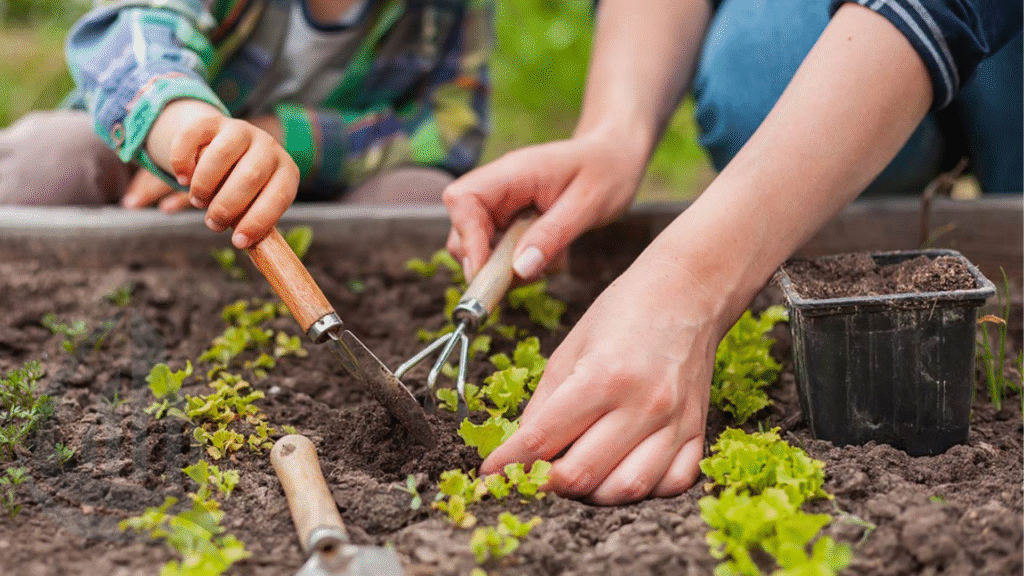
Style: The formal garden
The beauty of the formal garden lies in its symmetry, and a formal garden design might be the perfect match for you. Defined by symmetry, geometry, and balance, this style has charmed garden lovers for centuries.
- Use plants and pathways to create distinct areas, guiding the eye to focal points like statues or water features. This structured approach not only attracts the eye but also gives a sense of calm and order.
- Choosing the right plants is crucial in a formal garden. Select shrubs like boxwood or lavender to create elegant borders.
- Plant seasonal blooms like tulips or hydrangeas in neat rows for pops of colour. Don’t forget to add the seasons in your design, ensuring that something is always in bloom.
- For a decorative touch, add classic garden accessories, like containers or stone benches, to create inviting spaces. By focusing on these elements, your garden will transform into a timeless retreat that reflects your personal style.
- Even in smaller spaces, you can capture this beautiful style. Choose potted boxwood, rose borders, or gravel pathways, fountains, and sculptures to bring structure without losing warmth.
- Use a calm color palette of soft greens, whites, and blush tones to maintain an elegant ambiance.
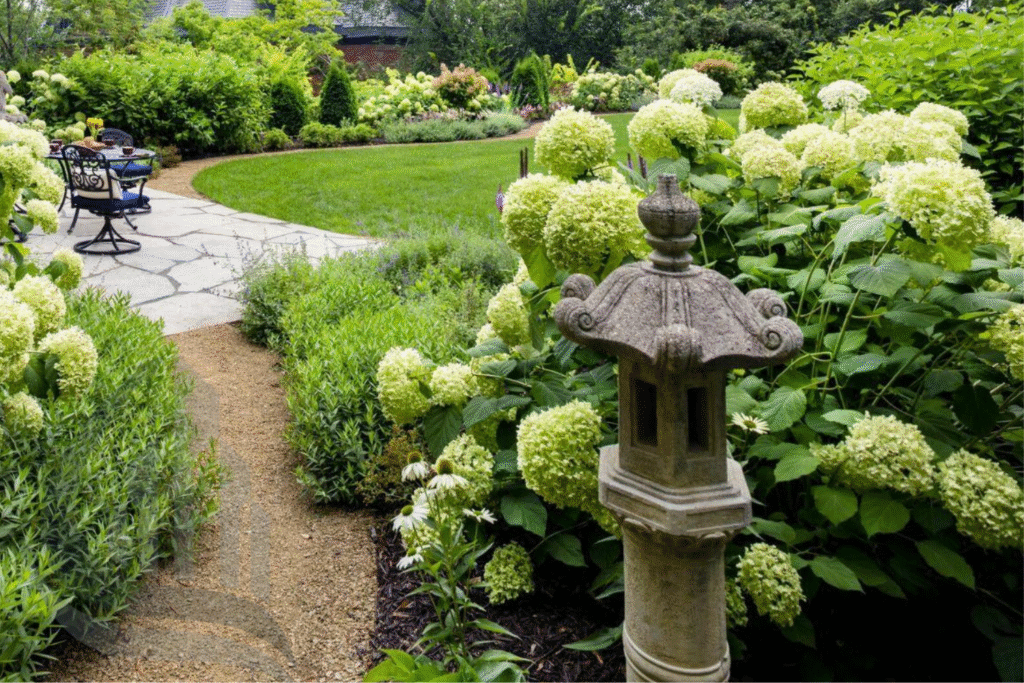
The informal garden
- If you want a garden that feels relaxed, romantic, and full of life, then the informal garden design is perfect for you.
- Start by choosing a variety of plants according to your senses. Mix flowers, herbs, and vegetables for both aesthetic appeal and practical use. Don’t worry about strict lines or symmetry; let the plants flow and mingle naturally.
- Next, consider the layout of your garden. Use curves instead of straight lines to guide the eye and create a sense of movement.
- Pathways made from stepping stones or rocks can enhance the informal feel while also providing access to different areas.
- Remember, the key to an informal garden is to focus on spontaneity; let your garden evolve and surprise you over time.
- Think of wildflowers, climbing roses, lavender, and ferns weaving together in a mix of colors, textures, and scents. Every part of the garden feels alive and a little bit whimsical, like nature’s art.
- Select a variety of seasonal flowers, soft shrubs, and lush greenery to create depth without adhering to a strict order.
- This style is ideal for small backyards or cottage-style gardens, where charm is achieved by layering plants and allowing them to grow naturally.
Structure
No matter what garden style you choose, formal, informal, or a mix of both, structure is what makes your space wonderful. Start by observing the patterns of sunlight in your space. This guide will help you select the right plants for sunny or shaded areas. Create zones within your garden, such as a vegetable patch, a flower bed, and a relaxation area.
Each section should serve a purpose, making the garden not just beautiful but also functional. As you plant, consider creating layers with tall plants at the back, medium ones in the middle, and shorter ones in the front, so every plant gets its moment to shine. Think of it as the garden’s invisible backbone: the pathways, borders, hedges, and focal points that hold everything together.
Structure doesn’t mean rigidity. In a formal garden, it might come from symmetry and straight lines; in an informal garden, it might be soft curves or layered planting. The key is balance – that is, giving your garden shape without taking away its soul.
Topiary(decorative shapes)
If you practice topiary in your yard, you’ll end up with shrubs and borders. Topiary refers to the art of cutting bushes into forms that bring timeless beauty. If you have a small balcony garden, then topiary adds structure, symmetry, and charm that lasts all year round.
- Start with simple shapes, such as spheres, cones, or cubes, and then progress to more advanced designs, like spirals, animal shapes, or obelisks. Use topiary frames to guide you, perfect for beginners.
- Cut lightly but frequently; this helps the plant to grow equally. Avoid overcutting. It’s better to trim in small sessions every few weeks.
- Topiary plants need consistent moisture but hate flooded soil. Add compost or organic materials to retain hydration and provide nutrients.
Pathways
The materials you choose for your pathways can transform the atmosphere of your garden. Visualise winding pathways that guide friends and family through your garden, inviting them to explore different areas. These paths can be made from natural materials like stone or wood, enhancing both functionality and aesthetics. Layering different materials can create a dynamic visual appeal, improving the overall design.
For a budget-friendly yet stylish option, consider using materials like gravel, stepping stones, or repurposed bricks. These are easy to install and add a soft, natural texture. If you want something more refined, consider paving stones or flagstones—they look elegant and timeless, especially when paired with neatly trimmed grass or small ground-cover plants growing between the gaps.
Next, think about layering your plants. Use taller plants at the back of your garden beds, with shorter ones in the front, to create depth and a sense of movement.
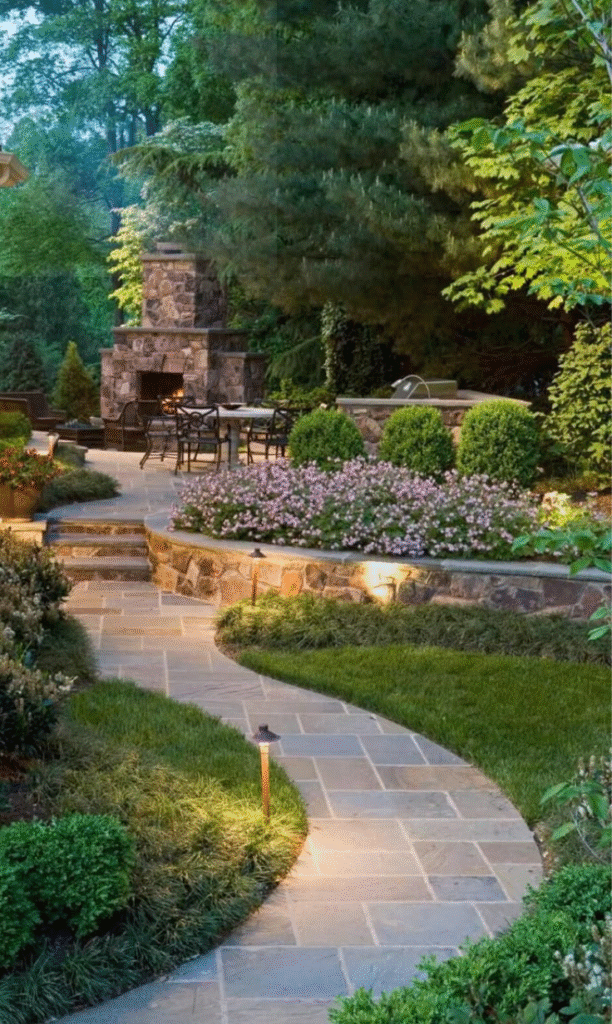
Basic elements of the garden: Grass
A garden isn’t just a patch of land; it’s a living space that welcomes us into nature’s embrace. At the heart of this beautiful creation are the basic elements: grass, flowers, and foliage. Grass serves as the foundation, providing a soft, welcoming carpet beneath your feet. Beyond its aesthetic appeal, it plays a vital role in supporting the ecosystem by attracting pollinators and encouraging healthy soil.
If you have extra space, try mixing short lawns with meadow-like areas. Let some parts of your grass grow longer and plant them with bulbs and wildflowers like snowdrops, crocuses, tulips, alliums, and even roses. Over time, this creates a magical meadow that feels natural and low-maintenance.
Flowers, bursting in a variety of colors and shapes, add vibrancy and fragrance that lift our spirits. They act as nature’s jewels, drawing both the eye and the heart. With simple attention to these basic elements, your garden can become a serene retreat filled with life and color, a place where one can escape the hustle and bustle of daily life.
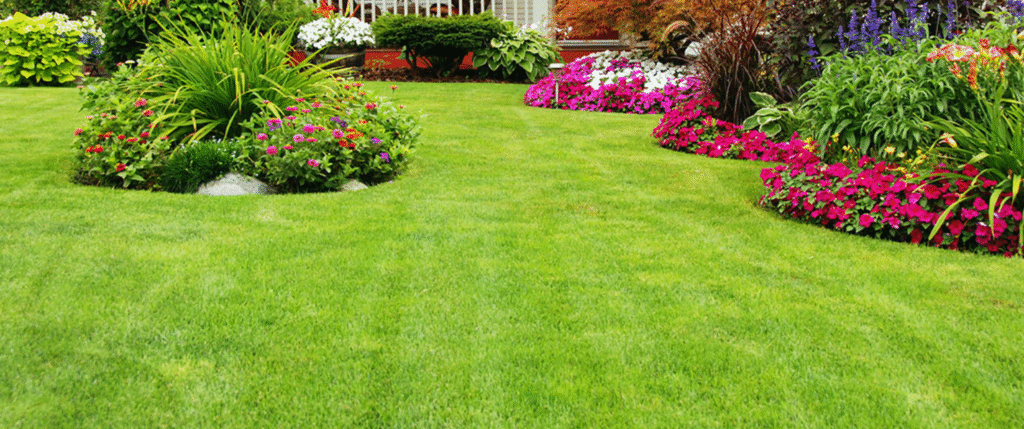
Containers
Containers offer flexibility and creativity, allowing you to plant anywhere, from your balcony to your backyard. Experimenting with different heights can add dimension; taller plants in the back and cascading flowers in the front create a stunning visual impact.
Consider mixing herbs and vegetables in decorative containers for a personal touch. You can use terracotta pots, ceramic planters, wooden boxes, or even recycled containers. Not only do they beautify your space, but they also provide fresh ingredients for your meals.
Plus, container gardening can make maintenance easier. It reduces the need for weeding and offers greater control over soil quality, resulting in healthier plants. With a bit of planning, you can transform any area into your own paradise, using containers as your canvas to paint a lush, inviting scene.

Water
Water is the lifeblood of any garden. You don’t need a large pond to enjoy the beauty of water. A simple bird bath, mini fountain, or small bowl pond can create the same relaxing effect. The gentle sound of a trickling fountain or the soft splash of water droplets on leaves after a refreshing rain. These elements not only refresh plants but also create an inviting atmosphere where nature flourishes.
When designing a garden, consider how water features can enhance its beauty and health. Water adds magic to a garden, with the gentle sound of trickling, the soft reflections, and the feeling of calm it brings. Even a small water feature can completely change the mood of your outdoor space, turning it into a peaceful retreat..
If you have more space, consider adding a pond edged with stones or flowering plants like water lilies, irises, or lotus. These not only look stunning but also attract birds, butterflies, and dragonflies, bringing your garden to life.
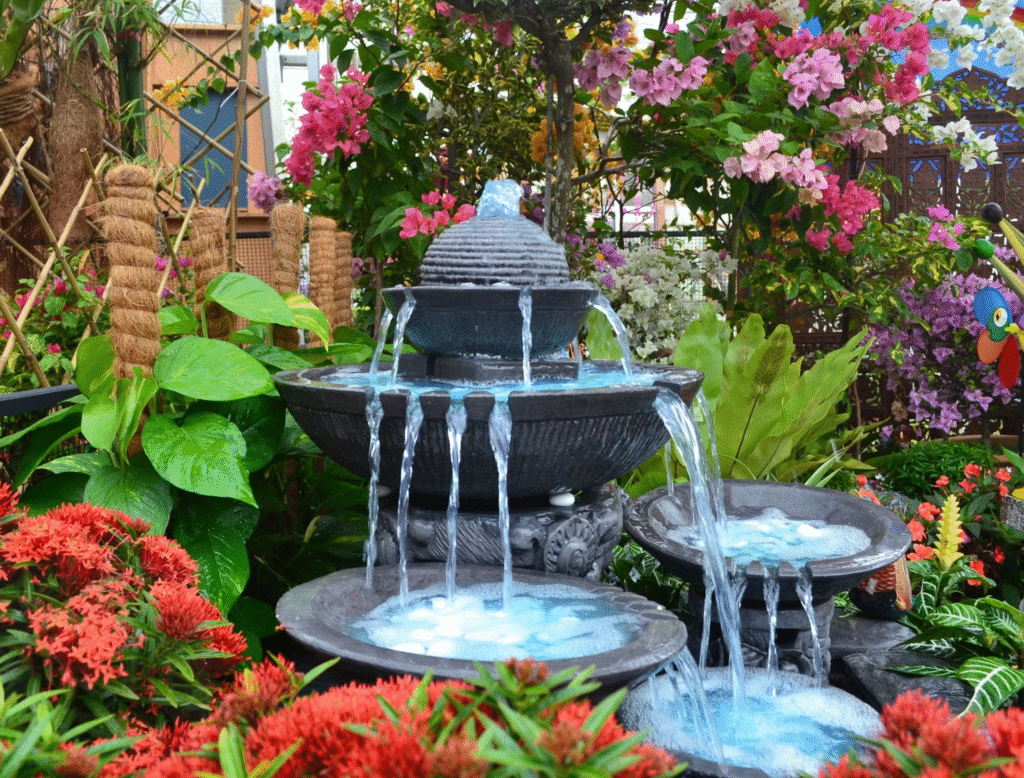
Growing fruit, vegetables, and herbs
Stepping into your garden, where vibrant colors and fresh scents envelop you. Designing a garden to grow fruit, vegetables, and herbs. For instance, tomatoes grow alongside basil, which not only wards off pests but also enhances flavor..
Start simple. If you’re new to growing, choose easy crops like lettuce, parsley, radishes, onions, or chard. They thrive with minimal effort and are great. Herbs such as rosemary and sage grow happily in borders or even through paving stones, adding fragrance and texture to your garden.
Start small. You don’t need a large space to grow something delicious. A few herb pots on a sunny windowsill, strawberries in hanging baskets, or tomatoes in containers can instantly bring freshness to your home. Herbs like basil, rosemary, mint, and thyme are easy to care for and fill the air with a beautiful scent.
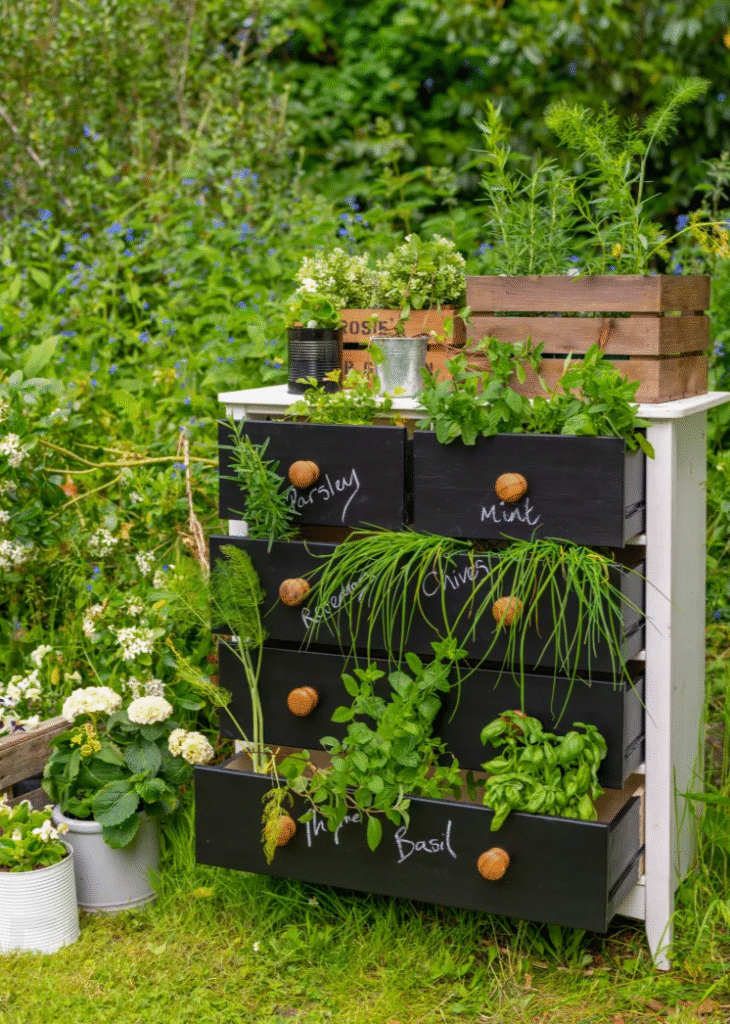
The sensory garden: Color
In the heart of a sensory garden, color becomes a language of its own. Vivid reds, serene blues, and cheerful yellows come together to create a unique vibe. The bright petals of marigolds might produce the warmth of an autumn afternoon, while the cool shades of lavender can instantly bring a sense of calm and peace.
According to the psychology of color, we see how our emotional responses depend on these shades. Green is often associated with nature and renewal, encouraging relaxation and mindfulness.
You don’t need many varieties to make an impact. Sometimes choosing a few shades makes your garden feel more elegant. Try planting in color blocks or gradients, letting one hue flow gently into the next.
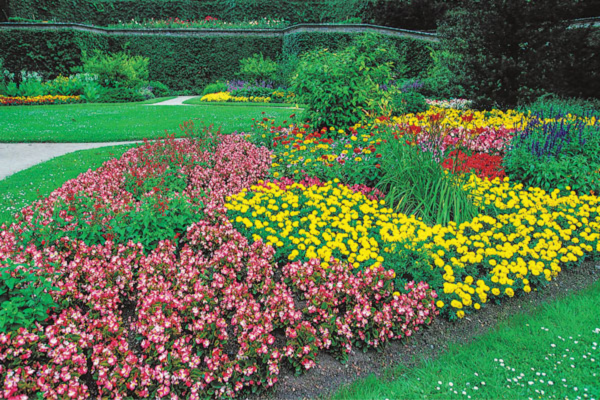
Scent
Walking through thin paths lined with fragrant roses, their rich scent invites you to pause and take a deep breath. By mixing various varieties, you can enjoy a vibrant display of colors and fragrances.
- Set fragrant plants near seating areas, pathways, and windows. A few jasmine vines near a doorway or pots of lavender can create an amazing sensory experience.
- Using fragrant herbs like mint, rosemary, thyme, and basil gives off a refreshing, natural scent. The earthy smell of rosemary can complement the floral notes of your blooms.
- Planting night-blooming flowers, such as evening primrose, which release their scents under the light of the moon, adds another layer of fragrance to your garden.
- The gentle perfume of flowers in the breeze can make your garden feel more welcoming, romantic, and alive.


